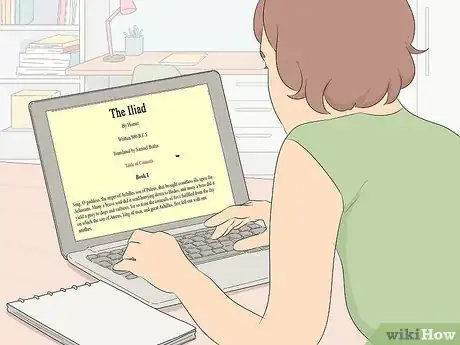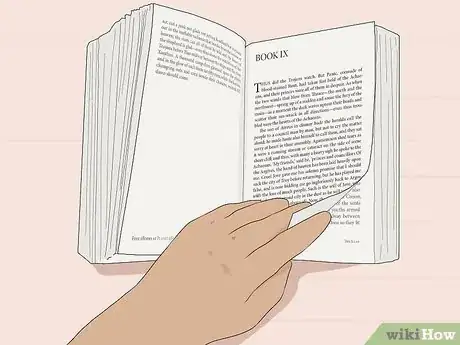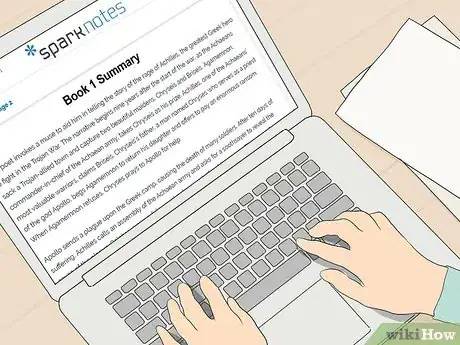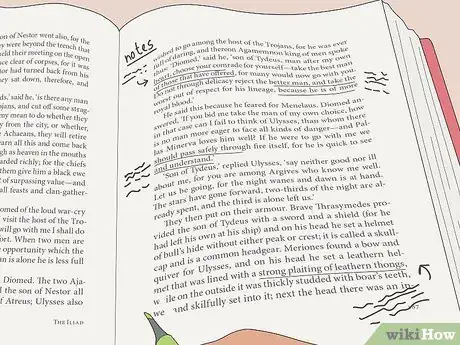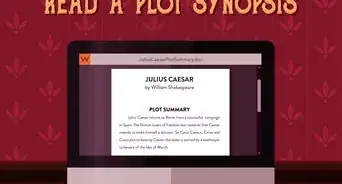This article was co-authored by wikiHow Staff. Our trained team of editors and researchers validate articles for accuracy and comprehensiveness. wikiHow's Content Management Team carefully monitors the work from our editorial staff to ensure that each article is backed by trusted research and meets our high quality standards.
This article has been viewed 24,773 times.
Learn more...
The Iliad by Homer is considered to be a masterpiece of Western literature. The story was composed around 800 B.C. and it is in verse-form. It describes the events of the Trojan War from around 1200 B.C. Many people are intimidated by the length of the Iliad and its status as ancient literature. However, the Iliad is much more accessible to modern readers than you might think and there are several helpful strategies that you can try if you want to read it.
Steps
Preparing to Read
-
1Choose a translation of the Iliad that’s easy to read. Since the Iliad has been translated into modern English, people often find it surprisingly easy to read. Look for a translation that includes footnotes, a glossary, and other helpful features that may help to make the reading process even easier for you.[1]
- MIT also has a free online version of the Iliad here: http://classics.mit.edu/Homer/iliad.html
- If you prefer to listen to books, you could also purchase an audiobook version of the Iliad.
-
2Familiarize yourself with the story of Helen and Paris. According to legend, Helen was the wife of Menelaus who fell in love with Paris and ran off with him, and this is what caused the Trojan War. This story occurs before the events of the Iliad. Read a full summary of what happened before the Trojan War. This way, you’ll understand what led up to it and have a good sense of what’s going on between the Greeks and the Trojans at the beginning of the Iliad.[2]
- You could also watch a film to learn about the events that came before the Trojan War, such as The Golden Age of Greece.
Advertisement -
3Learn about Greek mythology and other key figures in the Iliad. Since there are so many characters involved in the Iliad—mortals and gods—it can be confusing to dive right in without some understanding of who they all are. Read an overview of the key characters in the Iliad before you start reading it so that you will recognize them when you encounter their names.[3]
- This is another reason why having a text with a glossary or footnotes is helpful.
-
4Skip or skim certain chapters and focus on the most important ones. You can read the 600 page Iliad in its entirety, or you can follow a modified reading plan if you just want to understand the story on a more basic level. For example, you might read books 1, 2, 3, 6, 9, 11, 16, 18, 19, 22, and 24 to get a basic understanding of what happens in the Iliad.[4]
- This is a reading program that some instructors use to reduce the amount of time it takes for students to read the Iliad. The plan skips books that are less integral to the overall plot, such as long battle scenes. However, make sure to read summaries of the chapters you skip.
Tip: This might not be a good option if you’re reading the text for a class. Check with your instructor to find out if there are specific books that want you to focus on or if they expect you to read the whole thing.
Using Basic Reading Strategies
-
1Preview the content of each book by reading a summary. Read the title of a chapter and consider what this title indicates that the chapter will be about. You could also find a brief summary or synopsis of the chapter online and read it. This is called previewing and it helps to prime your brain and prepare it for the information it’s about to encounter.[5]
- For example, book 1 of the Iliad is called “The Mēnis of Achilles.” Mēnis means superhuman anger or wrath, so the title indicates that something will happen to make Achilles extremely angry. Indeed, in this chapter, Achilles has lost one of his comrades, Patroclus, to the battle and he also loses his lover, Briseis, to King Agamemnon.
- Repeat this process for each chapter in the Iliad.
-
2Read the poem aloud whenever possible. Since the Iliad was written in verse and was likely read aloud to entertain people, this is the ideal way to read the entire story. It’s not always practical to read out loud, such as if you’re reading the book in public, such as in a café or library. However, when possible, read the Iliad out loud.[6]
- For example, you could begin each book by reading aloud for the first 1-2 pages and then transition to silent reading. Pay attention to the way that the words sound, such as the rhythm, rhyme, and alliteration.
Tip: Listening to an audiobook is another great way to enjoy the way the poem sounds.
-
3Break your reading sessions up to improve your comprehension. The Iliad is a long text—24 chapters over 600 pages—so reading it within the space of a few days is not realistic. Plan to break your reading into several sessions over a period of weeks or months. If you want to read more than one chapter in a single session, try reading for 20-30 minutes at a time, and then take a 5-10 minute break to get up walk around, stretch, or get a snack.[7]
- Consider how much time you have to finish the book as you create your reading schedule. For example, if you have 6 weeks to read the entire Iliad, then you’d need to read 100 pages per week, which is about 14-15 pages per night.
-
4Write notes in the margins of your book to stay engaged. Underline interesting or important passages, comment on their significance, or ask questions about them. Always keep a pen or pencil in your hand while you read and think of reading the text as having a conversation with the author. This is called annotating and it’s an excellent way to stay focused on what you’re reading.[8]
- For example, in the section where Hector explains to his wife why he must return to the battlefield, you might comment on his sense of honor and how this demonstrates one of his heroic qualities.
Guiding Your Readings
-
1Identify heroic qualities and look for them as you read. The Iliad tells the story of more than one hero, so taking time to think about what qualities you find heroic and looking for them as you read may help you to retain more information about the characters. Try keeping a log of each character’s heroic qualities and then compare and contrast the characters’ qualities after you finish the text.[9]
- For example, you might compare and contrast Achilles with Hector. Both characters value their loved ones, but they put the greater good ahead of their personal desires. However, Hector is more accepting of his fate, while Achilles actively seeks revenge for the wrongs done to him.
-
2Create a running list of characters and their associations. Because there are so many characters in the Iliad, it can be hard to remember all of them and which side they are on. Try dividing a page in your notebook into 2 sections—Trojans and Greeks—and listing the characters you encounter on the camp they are associated with. Add details about their relationships as you continue with the text.[10]
- For example, you might list Hector on the Troy side along with his wife Andromache, while you’d list Achilles and Agamemnon on the Greek side.
-
3Ask questions as you read to enhance your comprehension. Questioning the text and looking for answers can help to keep you engaged and increase your comprehension. If you’re reading the Iliad for a class, ask your teacher if they have a list of questions that you can use to look for important details in each chapter. You can also find questions to guide your reading online, such as:[11]
- Why are the Trojans and Greeks at war?
- What are Agamemnon and Achilles angry at one another?
- What request does Achilles make of his mother, Thetis?
- Why does Hector visit his home during the first battle?
-
4Discuss or write a brief summary of each chapter. Immediately after you finish a chapter, review what happened to solidify the information in your mind. Try telling a friend, family member, or classmate about the events of the chapter and its key characters. Or, write a brief summary of what happened.[12]
Tip: Writing summaries may also be useful if you will be tested on the text at a later point. Reading back over what you’ve written can refresh your memory without actually having to re-read the chapter.
References
- ↑ https://teachersinstitute.yale.edu/curriculum/units/1984/2/84.02.09.x.html
- ↑ https://pages.ucsd.edu/~dkjordan/arch/iliad/IliadGuide01.html
- ↑ https://pages.ucsd.edu/~dkjordan/arch/iliad/IliadGuide01.html
- ↑ https://teachersinstitute.yale.edu/curriculum/units/1984/2/84.02.09.x.html
- ↑ https://pages.ucsd.edu/~dkjordan/arch/iliad/IliadGuide02.html
- ↑ https://teachersinstitute.yale.edu/curriculum/units/1984/2/84.02.09.x.html
- ↑ https://learningcenter.unc.edu/tips-and-tools/reading-comprehension-tips/
- ↑ https://learningcenter.unc.edu/tips-and-tools/reading-comprehension-tips/
- ↑ https://teachersinstitute.yale.edu/curriculum/units/1984/2/84.02.09.x.html
